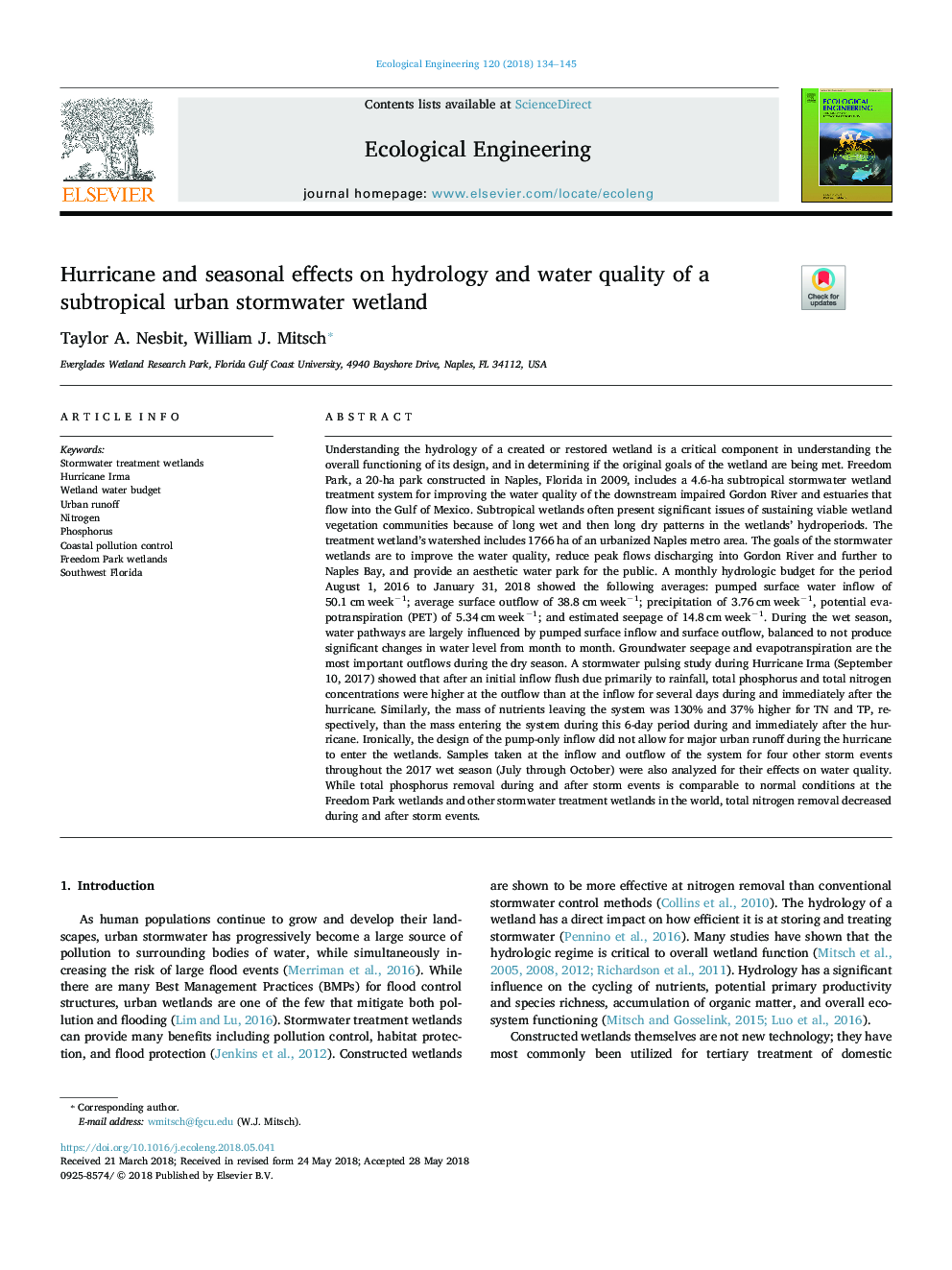| کد مقاله | کد نشریه | سال انتشار | مقاله انگلیسی | نسخه تمام متن |
|---|---|---|---|---|
| 8847772 | 1617982 | 2018 | 12 صفحه PDF | دانلود رایگان |
عنوان انگلیسی مقاله ISI
Hurricane and seasonal effects on hydrology and water quality of a subtropical urban stormwater wetland
ترجمه فارسی عنوان
طوفان و اثرات فصلی بر هیدرولوژی و کیفیت آب یک تالاب زیرزمینی طوفانی شهری
دانلود مقاله + سفارش ترجمه
دانلود مقاله ISI انگلیسی
رایگان برای ایرانیان
کلمات کلیدی
تالاب های تصفیه آب و فاضلاب، طوفان ایرما، بودجه آب تالاب، روان شهری، نیتروژن، فسفر، کنترل آلودگی ساحلی تالاب آزادی پارک، جنوب غربی فلوریدا،
موضوعات مرتبط
علوم زیستی و بیوفناوری
علوم کشاورزی و بیولوژیک
بوم شناسی، تکامل، رفتار و سامانه شناسی
چکیده انگلیسی
Understanding the hydrology of a created or restored wetland is a critical component in understanding the overall functioning of its design, and in determining if the original goals of the wetland are being met. Freedom Park, a 20-ha park constructed in Naples, Florida in 2009, includes a 4.6-ha subtropical stormwater wetland treatment system for improving the water quality of the downstream impaired Gordon River and estuaries that flow into the Gulf of Mexico. Subtropical wetlands often present significant issues of sustaining viable wetland vegetation communities because of long wet and then long dry patterns in the wetlands' hydroperiods. The treatment wetland's watershed includes 1766â¯ha of an urbanized Naples metro area. The goals of the stormwater wetlands are to improve the water quality, reduce peak flows discharging into Gordon River and further to Naples Bay, and provide an aesthetic water park for the public. A monthly hydrologic budget for the period August 1, 2016 to January 31, 2018 showed the following averages: pumped surface water inflow of 50.1â¯cmâ¯weekâ1; average surface outflow of 38.8â¯cmâ¯weekâ1; precipitation of 3.76â¯cmâ¯weekâ1, potential evapotranspiration (PET) of 5.34â¯cmâ¯weekâ1; and estimated seepage of 14.8â¯cmâ¯weekâ1. During the wet season, water pathways are largely influenced by pumped surface inflow and surface outflow, balanced to not produce significant changes in water level from month to month. Groundwater seepage and evapotranspiration are the most important outflows during the dry season. A stormwater pulsing study during Hurricane Irma (September 10, 2017) showed that after an initial inflow flush due primarily to rainfall, total phosphorus and total nitrogen concentrations were higher at the outflow than at the inflow for several days during and immediately after the hurricane. Similarly, the mass of nutrients leaving the system was 130% and 37% higher for TN and TP, respectively, than the mass entering the system during this 6-day period during and immediately after the hurricane. Ironically, the design of the pump-only inflow did not allow for major urban runoff during the hurricane to enter the wetlands. Samples taken at the inflow and outflow of the system for four other storm events throughout the 2017 wet season (July through October) were also analyzed for their effects on water quality. While total phosphorus removal during and after storm events is comparable to normal conditions at the Freedom Park wetlands and other stormwater treatment wetlands in the world, total nitrogen removal decreased during and after storm events.
ناشر
Database: Elsevier - ScienceDirect (ساینس دایرکت)
Journal: Ecological Engineering - Volume 120, September 2018, Pages 134-145
Journal: Ecological Engineering - Volume 120, September 2018, Pages 134-145
نویسندگان
Taylor A. Nesbit, William J. Mitsch,
